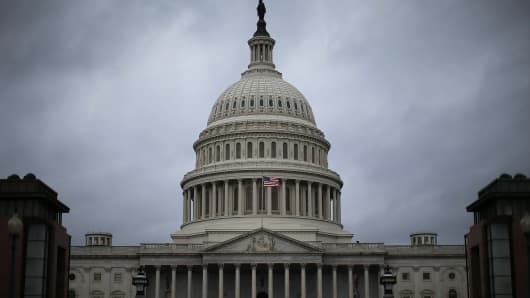In the coming weeks, Congress will determine who shall pay for the losses that corporations would suffer from a future terrorist attack on U.S. soil by deciding in what form the Terrorism Risk Insurance Act (TRIA) should be renewed.
The terrorist attacks of Sept. 11, 2001 inflicted $32.5 billion of insured losses ($44 billion in 2014 dollars). After paying these claims, insurers and reinsurers stopped providing coverage for terrorism in the United States unless required to do so. As a result, most businesses operating in the United States found it increasingly difficult to purchase commercial property insurance that included the risk of terrorism.
Read MoreSenate votes to extend terrorism-insurance program
To address this problem, TRIA was passed as a temporary program in 2002 and designed as a risk-sharing partnership between the insurance industry, commercial policyholders and the federal government (taxpayers) covering up to $100 billion of insured commercial losses. Insurers assume the first tranche of the risk via a deductible and then cover 15 percent of losses above this amount. The federal government would cover the remaining 85 percent without charging insurers for that protection. By law a portion of this federal payment will be recouped over time against all commercial insurance policyholders — small and large businesses alike — even if they are not covered against terrorism losses.
TRIA addresses the demand for terrorism coverage by requiring all U.S. primary insurance companies to offer protection against terrorism risk on the same terms and conditions as other perils provided by their commercial policies. Firms are not required to purchase this coverage unless required by state law. Today, about 60 percent of large businesses across America are insured against losses from terrorist attacks. This leaves 40 percent uninsured.
Read MoreRussian media on downed airline: The CIA did it
The continued lack of a viable private terrorism-insurance market led to TRIA's renewal in 2005 for two years and again in 2007, this time for seven years until December 2014. At each renewal, the portion of the risk assumed by the private sector (the insurance industry and commercial policyholders) was significantly increased.
A consensus has emerged that TRIA should be renewed once again. The question facing Congress and the Obama administration is whether the program should be modified, and if so, in what ways. Some constituencies would like even more of the risk transferred to the private sector, which was embodied in Senate bill (S. 2244) passed last week and the House Financial Services Committee bill (H.R. 4871) passed at the end of June. Insurers favor maintaining the current program to protect themselves against catastrophic losses from a future terrorist attack in large metropolitan areas.
To shed light on the current debate, we are releasing a new report, "TRIA after 2014," that provides quantitative analyses on the impacts of the Senate and House committee bills and their differing risk-sharing arrangements under a renewed TRIA. The analyses are based on several scenarios of financial losses from terrorist attacks in Chicago, Houston, Los Angeles and New York, provided by the modeling firm Risk Managements Solutions and the impacts on 750 insurers operating in these markets.
Read MoreOpinion: Stop trying to force companies to stay in the US
The findings that we will present at a briefing in the U.S. Senate on July 24 surprised us and others. We find, for instance, that under the current program, losses from a terrorist attack would have to exceed $40 billion before the taxpayers pay a penny. The Senate and House bills would raise the taxpayer threshold level anywhere from 30 percent to 85 percent.
One story that has not been widely discussed is the portion of the loss that will end up being paid by all commercial policyholders as part of the mandatory federal recoupment mentioned above. Consider a $50 billion attack against New York City. Under TRIA today, all insured commercial enterprises across the nation would pay about $7 billion. It could be nearly $17 billion under the Senate bill and as high as $18 billion under the House bill.
TRIA is important for another reason: Structuring disaster financing before a catastrophe occurs reduces the uncertainty that would otherwise face small and large business owners as to whether or not they will be compensated for losses incurred from a terrorist attack. Absent TRIA, and the refusal of insurers to cover this risk on their own, many more businesses would be uninsured and financially distressed after an attack and their employees would be uncertain as to their employment status. Given past experience with natural disasters and the financial bailout, the federal government would very likely come to the rescue. Taxpayers would thus be more exposed to losses than if TRIA were in place.
Congress must decide soon about the risk-sharing parameters in a renewed program. We hope our new analysis will help the Senate and House, the White House and all commercial enterprises in America make a more informed decision.
Commentary by Howard Kunreuther and Erwann Michel-Kerjan, professors at the Wharton School of the University of Pennsylvania in Philadelphia, PA; they are co-director and executive director of the Wharton Risk Management and Decision Processes Center, respectively; and faculty affiliates of the Penn Wharton Public Policy Initiative.


